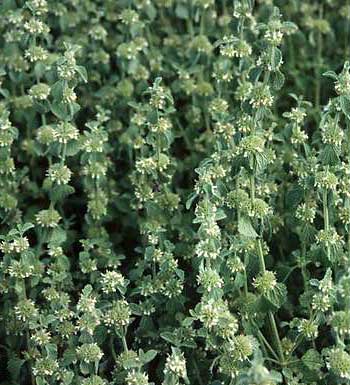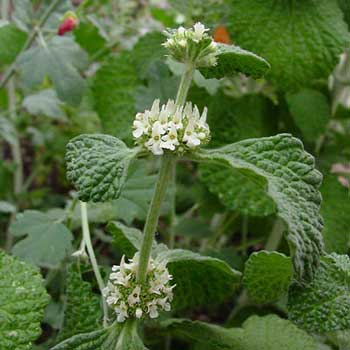Contents:
Common Names | Parts Usually Used | Plant(s) & Culture | Where Found | Medicinal Properties | Biochemical Information
Legends, Myths and Stories | Uses | Formulas or Dosages | Nutrient Content | How Sold | Bibliography
Scientific Names

- Marrubium vulgare L.
- Labiatae
- Mint family
Common Names
- Hoarhound
- Marrubium
- White horehound
Parts Usually Used
Flowers and leaves (fresh or dried in the shade)
Back to Top

Description of Plant(s) and Culture
Horehound is a strongly, rank-scented perennial plant with a dense covering of white hairs, growing 2-3 feet tall; a fibrous, spindle-shaped rootstock send up numerous bushy, square, downy stems. The root is blackish, hard and woody, with many strings. The leaves with rounded teeth on the margins are opposite, petioled, usually wrinkled, roundish-ovate, rough on top, and woolly underneath. The small, white, dense, two-lipped flowers feature a spiny, toothed, calyx with 10 bristly, curved teeth, and grow in axillary whorls on the upper leaves; from June to September. Full sun. Zones 4-9. After blooming time appear small round blackish seed. Seed ripen in August.
Another variety: Black horehound (Ballota nigra), also known as hen-bit, is used to relieve morning sickness.
Back to Top
Where Found
Found in waste places, sheep pastures, vacant lots, abandoned fields, dry, sandy spots, in upland fields and pastures, and along roadsides in coastal areas of the United States, Canada, Mexico, and Europe. Native of southern Europe, Asia, North Africa, the Canary Islands, and the Azores.
Back to Top
Medicinal Properties
Anthelmintic (large doses), antispasmodic, diaphoretic, diuretic, expectorant, laxative, stimulant, stomachic, tonic
Back to Top
Biochemical Information
Iron, marrubiin, volatile oils, potassium, resin, tannins, the B complex, and vitamins A, C, E, and F.
Back to Top
Legends, Myths and Stories
The Egyptians called this plant the seed of Horus, bull’s blood, and eye of the star.
For centuries a cough remedy, horehound was used by Hippocrates to treat a variety of ailments.
Called an herb of Mercury, the horehound was used widely as a medicine by the Egyptians, Greeks, and Romans. The Greeks often used it as an anti-spasmodic drug and as an antidote for the bite of a ad dog, hence its common name, hoarhound.
It is one of the bitter herbs that the Jews eat at Passover time, the others being nettle, horseradish, coriander, and lettuce. The common name of horehound, originating from the Hebrew, “marrob,” meaning “a bitter juice”.
Dioscorides claimed a decoction of the dried herb with seed, or the juice of the green herb taken with honey, is a remedy for those that are short-winded.
Horehound can help relieve the dragged-out, sluggish feeling that often accompanies a bad cold or the flu. Also, rids the body of excess water.
Back to Top
Uses
Take for coughs, common colds, asthma, jaundice, fever, chronic sore throat, consumption, hoarseness, stimulate appetite, intestinal gas, gallbladder disorders, hepatitis, laxative, asthma. Decreases thickness and increases fluidity of mucus in bronchial tubes and lungs. Fresh leaves poulticed on cuts, wounds. Volatile oil is an expectorant, acts as a vasodilator, calms the heart, and relieves palpitations. The malodorous, bitter leaves are a well-known ingredient in cough syrups and throat lozenges. In large doses it is a laxative. Taken cold for dyspepsia, hysteria, and will expel worms.
As an expectorant, it can be taken as a tea, a syrup, or a dilute alcoholic extract for acute or chronic bronchitis. Horehound is also given for typhoid fever and paratyphoid fever. It is said to restore the normal balance of secretions by various organs and glands. Try it for nervous heart conditions, to calm heart action. Taken warm, the infusion is diaphoretic and diuretic; taken cold, it makes a good stomach tonic. Externally, either the tea or the crushed leaves can be applied for temporary or persistent skin problems, and shingles.
Culpeper states it was given to “them that have taken poison, or are stung or bitten by venomous serpents.” The leaves used with honey heal external ulcers, sores; helps pain, helps clear eyesight
Back to Top
Formulas or Dosages
Can be used fresh or dried.
Infusion: steep 1 tsp. herb in 1/2 cup water. Take 1 to 1 1/2 cups a day, a mouthful at a time. Sweeten with honey if taken for lung or heart problems.
Syrup: add a pound of sugar to 1 pint of infusion.
Cough syrup: boil 1/4 cup dried horehound with 2 cups water for 10 minutes; strain. Combine one part of the mixture with 2 parts honey; stir until smooth. Children can drink this mixture freely for coughs and sore throat.
Extract: for coughs, a tea made from 10-40 drops of extract in warm water works best. Use up to 3 times daily.
Juice: take 1 tsp. fresh juice, 2 times a day.
Tincture: take 5-40 drops in hot water, as needed.
Back to Top
Nutrient Content
Iron, potassium, the B complex, and vitamins A, C, E, and F.
Back to Top
How Sold
Cough drops
Medicinal candy
Cough syrup
Back to Top
Bibliography
![]() The Herb Book
The Herb Book, by John Lust, Bantam Books, 666 Fifth Avenue, New York, NY. copyright 1974.
![]() Eastern/Central Medicinal Plants
Eastern/Central Medicinal Plants, by Steven Foster and James A. Duke., Houghton Mifflin Company, 215 Park Avenue South, New York, NY 10000
Herbal Gardening, compiled by The Robison York State Herb Garden, Cornell Plantations, Matthaei Botanical Gardens of the University of Michigan, University of California Botanical Garden, Berkeley., Pantheon Books, Knopf Publishing Group, New York, 1994, first edition
 The Magic of Herbs
The Magic of Herbs, by David Conway, published by Jonathan Cape, Thirty Bedford Square, London, England. (Out of print)
![]() Culpeper’s Complete Herbal & English Physician: Updated With 117 Modern Herbs
Culpeper’s Complete Herbal & English Physician: Updated With 117 Modern Herbs, by Nicholas Culpeper, Meyerbooks, publisher, PO Box 427, Glenwood, Illinois 60425, 1990, (reprint of 1814)
 Earl Mindell’s Herb Bible
Earl Mindell’s Herb Bible, by Earl Mindell, R.Ph., Ph.D., Simon & Schuster/Fireside, Rockefeller Center 1230 Avenue of the Americas, New York, New York 10020
![]() The Herbalist Almanac
The Herbalist Almanac, by Clarence Meyer, Meyerbooks, publisher, PO Box 427, Glenwood, Illinois 60425, copyright 1988, fifth printing, 1994
![]() Back to Eden
Back to Eden, by Jethro Kloss; Back to Eden Publishing Co., Loma Linda, CA 92354, Original copyright 1939, revised edition 1994
![]() Indian Herbalogy of North America
Indian Herbalogy of North America, by Alma R. Hutchens, Shambala Publications, Inc., Horticultural Hall, 300 Massachusetts Avenue, Boston, Massachusetts 02115, 1973
![]() The Complete Medicinal Herbal
The Complete Medicinal Herbal, by Penelope Ody, Dorling Kindersley, Inc, 232 Madison Avenue, New York, NY 10016, First American Edition, copyright 1993
![]() Planetary Herbology
Planetary Herbology, by Michael Tierra, C.A., N.D., O.M.D., Lotus Press, PO Box 325, Twin Lakes. WI 53181., Copyright 1988, published 1992
![]() American Folk Medicine
American Folk Medicine, by Clarence Meyer, Meyerbooks, publisher, PO Box 427, Glenwood, Illinois 60425, 1973
![]() Prescription for Nutritional Healing, Fifth Edition: A Practical A-to-Z Reference to Drug-Free Remedies Using Vitamins, Minerals, Herbs & Food Supplements
Prescription for Nutritional Healing, Fifth Edition: A Practical A-to-Z Reference to Drug-Free Remedies Using Vitamins, Minerals, Herbs & Food Supplements, by James F. Balch, M.D. and Phyllis A. Balch, C.N.C., Avery Publishing Group, Inc., Garden City Park, NY
![]() Webster’s New World Dictionary
Webster’s New World Dictionary, Third College Edition, Victoria Neufeldt, Editor in Chief, New World Dictionaries: A Division of Simon & Schuster, Inc., 15 Columbus Circle, New York, NY 10023
 An Instant Guide to Medicinal Plants
An Instant Guide to Medicinal Plants, by Pamela Forey and Ruth Lindsay, Crescent Books (January 27, 1992).
![]() The Yoga of Herbs: An Ayurvedic Guide to Herbal Medicine
The Yoga of Herbs: An Ayurvedic Guide to Herbal Medicine, by Dr. David Frawley & Dr. Vasant Lad, Lotus Press, Twin Lakes, Wisconsin, Second edition, 1988.
 The Rodale Herb Book: How to Use, Grow, and Buy Nature’s Miracle Plants (An Organic gardening and farming book)
The Rodale Herb Book: How to Use, Grow, and Buy Nature’s Miracle Plants (An Organic gardening and farming book), edited by William H. Hylton, Rodale Press, Inc. Emmaus, PA, 18049., 1974
![]() Country Home Book of Herbs
Country Home Book of Herbs, Meredith Books, Editorial Dept. RW240, 1716 Locust Street, Des Moines, IA 50309-3023, copyright 1994
